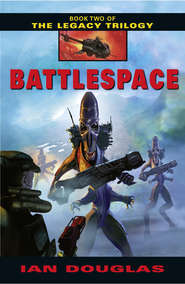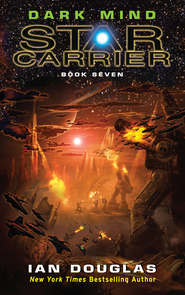По всем вопросам обращайтесь на: info@litportal.ru
(©) 2003-2024.
✖
Dark Matter
Настройки чтения
Размер шрифта
Высота строк
Поля
Obviously, it hadn’t worked out as planned. The Confederation had dispatched a naval squadron to seize Enceladus and to isolate North America from the rest of Earth’s scientific community.
None of this was of particular interest to Gallagher at the moment, as he skimmed above the polar ice toward a misty wall, which, at his current velocity, would have nearly the same effect on his ship as a cliff of solid ice. He gave orders to his AI, nudging the fighter into a slightly different path. Those tiger stripes each were about 35 kilometers apart. It would be like threading a needle, but he might slip between the plumes if he could maintain a low-enough altitude.
The Pan-European fighters were still behind him, following him in.
Hurtling between two towering plumes that filled the sky with misty light, Gallagher flipped his fighter end for end again, hurtling tail-first and head-down, meters above the roiled and jaggedly broken icy surface. He had one Krait remaining. He rolled back to keel-down, giving orders to his AI in brief, staccato bursts of thought.
“Fox One!”
His last Krait dropped from his keel, ignited, streaked aft . . . and detonated on the ice. The flare was blinding . . . and an instant later a fresh and violent plume of freezing water geysered into space above the hole he’d punched into the surface, directly in the path of the trailing enemy fighters.
Unfortunately, the expanding plasma shock wave from his missile caught the Starhawk and nudged it to one side, nudged it enough to send it skimming through the fringes of one of the other plumes. Gallagher felt a savage shock, saw pieces of his fighter ripping free . . .
. . . and then the jolt of deceleration slammed against him, sending him hurtling into blackness as he lost consciousness. . . .
Chapter Six
4 March 2425
Emergency Presidential Command Post
Toronto
United States of North America
1640 hours, EST
“The President of the Confederation Senate is on the link for you, Mr. President,” Marcus Whitney, the Chief of Staff, said. “The new President, I should say.”
President Koenig glanced at the others in the room—Pamela Sharpe, the Secretary of State. Lawrence Vandenberg, the Secretary of Defense. Dr. Neil Eskow, the Secretary of Science. All maintained facial expressions of careful neutrality.
“You have the security issues worked out already, I presume?”
“Of course, sir.”
The security problem was far more difficult than merely one of virus control. A direct data link between Geneva and the emergency USNA capital in Toronto could easily serve as a conduit for a variety of electronic attacks—viruses, worms, or brute-force virtual assaults aimed at downloading confidential data or knocking out the American communications network. Powerful e-security AIs would be monitoring the exchange on both sides of the Atlantic, making sure that only the video and sound being exchanged between the two government leaders would pass the firewalls.
There was also the question of e-psych attacks, which would amount to a direct assassination attempt. Koenig and his Confederation counterpart carried sophisticated nanochelated circuitry inside their brains, cerebral implants that let them interface directly with computers, vehicle control systems, medical scans, the Global Net, and, of course, mind-to-mind communications links. It was possible to hack another person’s implants, either to steal data or—more viciously—to infiltrate personal RAM and distort the victim’s perception of reality. Such an attack could leave a victim hopelessly insane . . . or so distort his reality that he acted as though he were schizophrenic.
The virtual agents resident within implant hardware—Koenig’s personal in-head secretary, for instance—were designed to screen out such attacks . . . if only to block unauthorized attempts at communication, or the transfer of electronic advertising. The ICEware carried by Koenig and other government leaders was several orders of magnitude more powerful and comprehensive than what was available to average citizens, and should be proof against any possible electronic attack.
There was always the chance that the other side had come up with something new, however. The electronic battleground was constantly evolving, constantly growing more complex, more subtle, and more dangerous.
The secretary of defense broke the uncomfortable silence first. “Sir,” Vandenberg said, “I really don’t think that taking this call is a good idea.”
“Why is that?”
“Simple. It’s likely to be a plot to get at you. They might have something new that our ICE can’t handle. Something dangerous.”
ICE, an old acronym for intrusion countermeasures electronics, was the catchall term for electronic software defenses, some of it artificially intelligent, some not.
“Konstantin says they do not,” Dr. Eskow said with a shrug. “And Konstantin should know. It monitors the Global Net closely, and would be aware of any such new developments.”
“I don’t see Konstantin running our antiviral software,” Vandenberg said.
“Of course not,” Koenig said. “The time lag from the moon and back is too long. God knows what could sneak through in three seconds.”
In fact, clones of Konstantin were already running on several USNA networks on Earth, though they were more closely circumscribed in operational procedures and restrictions than was the hyperintelligent AI on the moon’s far side. Most humans still didn’t fully trust AIs that were too intelligent . . . or too independent.
And Koenig didn’t fully trust any AI networks that might already have been compromised by Confederation hacks.
Still, there were times when you needed to take a chance. If you sat inside a sealed box doing nothing because someone out there might be trying to get you, you would never get anywhere.
“I’m going to take the call,” Koenig said, deciding. “I’m sick of working in the dark against these people. Maybe he’ll let something slip.”
“Stay behind your avatar, Mr. President,” Eskow said. “He’ll certainly be staying behind his.”
Avatar was the term given to a computer-created simulation based on the real person. With a decent AI behind it, it could even mimic the organic personality so closely that people linking in on the Net could not tell whether they were talking to the person or to their electronic secretary. Avatars could be a convenience or they could be a kind of personality fashion statement. They also could be designed to create a certain psychological impact. What Eskow was suggesting was that Koenig remain electronically masked by his avatar in the conversation. If the Confederation did manage to slip a nasty worm through the link, it would hit the electronic presence first, and, with luck and some very fast electronic reactions, be stopped there.
But that would also mean that Koenig would be isolated from the discussion, experiencing it secondhand and with little opportunity to guide it. He shook his head.
“I’ll be careful, Doctor. But there’s no point in my being here if I’m going to let an electronic puppet do my talking for me.” He looked at his SecState. “Pam? What’s the global lineup right now? Has anything changed I should know about?”
“Nothing substantial has changed since this morning’s PICKL, Mr. President,” she said. The PICKL was the President’s Intelligence ChecK-List, a data download prepared by the various USNA intelligence services for his review first thing each morning. “We have feelers out to Brasilia. They may pull out of the war over the Columbus atrocity, though they probably will stay with the Confederation. If they stay with the Confederation, Argentina may pull out. Those two are still at each other’s throats.”
“Russian Federation? North India?”
“They’re both solidly with us, now. But we’re not yet sure how much practical use those alliances might provide.”
“And Mexico?”
“Still solidly against us, sir. Confederation agents have been promising them the return of the old U.S. Southwest.”
“Aztlan,” Koenig said, frowning and nodding. “I know. Old news. Okay, let’s do this. Marcus?”
“The link is ready, sir. He’s waiting. Or his avatar is.”
“Right.” Koenig sank back in his chair, which responded to his thoughts, opening up, opening back, letting him lie back in a reclining position. He closed his eyes, and an inner window opened. A face formed out of static, and in Koenig’s mind’s eye, he was seated now in a large conference room, across an expensive mahogany table from President Christian Denoix de Saint Marc.
He was surprised at first that he wasn’t sitting opposite General Janos Matonyi Korosi who, according to USNA Intelligence, was currently the real head of both Pan-Europe and the Confederation. But Denoix’s presence was not, perhaps, all that surprising. The Confederation would be scrambling to put a legitimate face on their war—and that meant a civilian leader, not a military one. Denoix might well be little more than a figurehead. It would be good to keep that in mind.
Вы ознакомились с фрагментом книги.
Приобретайте полный текст книги у нашего партнера:
Приобретайте полный текст книги у нашего партнера:











